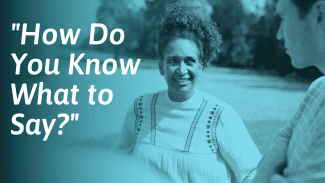Do you feel awkward talking to strangers, particularly in busy, extrovert-friendly environments like parties or bars? You might already know that it will get easier with practice, but getting that practice can seem impossible, particularly if you’re an introvert.
There are three parts to becoming an expert at talking to strangers; approaching strangers, knowing what to say, and managing your feelings about the conversation.
Here are some tips to help you with all three stages.
Sections
How to talk to strangers
Striking up conversations with people you don’t know can be daunting. Having a good conversation with a stranger is as much about how you act as what you say. Here are 13 tips to help you talk to strangers.
1. Focus on positive topics
Start by making genuine, positive comments about your surroundings or the situation. Talking about positive experiences or things you both enjoy can create a comfortable and friendly atmosphere. This signals to the other person that you are open and accepting, which can encourage them to open up to you as well.
While it’s okay to have differing opinions on sensitive or controversial topics, it’s best to avoid them when you first meet someone. Instead, try to find common ground and positive things to talk about.
For example, if you’re waiting in line for coffee, you might comment on how great the weather is or ask if they have any fun plans for the weekend. By keeping the conversation light and positive, you can help build a foundation for a pleasant interaction.
2. Have a relaxed, friendly smile
A smile, even if it’s subtle, can mean the difference between someone assuming you’re inviting and starting a conversation or moving on, afraid you’re aloof or grumpy. Most people fear rejection, so they’ll avoid people who look like they aren’t happy to talk.
If you find it difficult to smile, there are other ways you can show friendliness and approachability. One option is to use a friendly tone of voice. You can also engage in open body language by uncrossing your arms and facing the person you are speaking with. Additionally, you can use small gestures such as nodding or leaning in slightly to show that you are actively listening to the other person.
Remember that a smile is just one way to convey warmth and openness, and there are many other nonverbal cues that can be just as effective in making others feel comfortable around you.
3. Know that it’s OK to make trivial remarks
People don’t expect someone to be brilliant and charismatic when they first meet them. Be a good listener. Be open and friendly. Make casual observations about the event or your surroundings. Say what’s on your mind, even if it’s not profound. Something as mundane as “I love this couch” signals that you’re warm, and it can spark an interesting conversation. The brilliant insights can come later when you know each other better, and you’re getting deeper into a topic.
4. Pay attention to their feet and their gaze
Are they looking at you with their feet pointed toward you? These are the signs that the person you’re talking to is engaged in the conversation, and they want to keep going.
Every couple of minutes, check the direction of their gaze. If they are continually looking over your shoulder or turning their body away from you, starting with their feet, they’ve got other things on their mind and are probably too distracted to continue.
Read more: How to know if someone wants to talk to you.
5. Show that you enjoy talking with someone
Sometimes we’re so wrapped up in being cool that we forget to be passionate, and that is infinitely more likable. If you show a person that you enjoyed talking to them, they’ll be more motivated to speak to you again. “Hey, I haven’t had a philosophical conversation like this in a while. I really enjoyed it.”
6. Maintain eye contact
Eye contact tells people that you’re interested in what they’re saying. Yet there’s a thin line between too much eye contact and too little. A good rule of thumb is to make eye contact when the person you’re talking to is speaking. When you’re speaking, look at your partner to keep their attention. Lastly, when either of you is thinking between comments, you can break eye contact.
Have a look at this article on eye contact to learn more.
7. Use your surroundings for inspiration
When you meet someone, take a look around and make observations about what’s going on around you. Remarks like, “This meeting room has the best windows” or “I wonder if we’re getting lunch, as this is an all-day meeting?” are casual, spur-of-the-moment comments that signal you’re easy to talk to and friendly.
8. Ask the right questions
Don’t ask questions for the sake of asking questions. It makes the conversations boring and robotic. Try to make your questions slightly personal. You don’t want to make people uncomfortable, but you do want to get to know them.
Say you’re talking about how high rent is in your neighborhood. Then you turn the conversation into “Personal Mode” and add that in a few years you want to buy a house in the countryside. Then you ask them where they think they’ll be living in a few years.
All of a sudden, you’re asking questions to get to know someone and the conversation is about F.O.R.D. topics (Family, Occupation, Recreation, Dreams) which are much more fun and revealing.
9. Treat a stranger as you would treat a friend
When you’re chatting with friends, you probably feel relaxed. You smile when you see them. You ask them how they’re doing. You talk about what you’ve both been up to. The interaction flows smoothly.
When you meet new people, treat them the same way. Think of a topic you’d bring up with a friend and use that as inspiration.
For example, if you’re talking to someone you don’t know very well at work, ask them how their projects are going. Are they super-busy, or is it the regular workload? If you’re at school, ask someone about their classes. Be casual and friendly without being overly familiar.
10. Allow 1-2 seconds of silence before you speak
Your heart might be racing, but that doesn’t mean your speech must rush along too. If you answer really quickly, it can make you seem overeager or that you aren’t confident in what you’re saying. Take a beat of one or two seconds before you answer, and that will give the impression that you’re relaxed. After you do it for a while, it will become natural, and you won’t need to think about it.
11. Find commonalities
Look for mutual interests. You can do this by mentioning things you like and see how they react. If you enjoy history, you can check if the other person might too:
Them: “What were you up to this weekend?”
You: “I watched this fascinating documentary about the Civil War. It’s about how…”
If they react favorably, you could use history as a mutual interest to bond around. If they don’t seem interested, mention some other interest you have at a later point.
Or, when you talked about the weekend, maybe you learned that they play hockey. If you’re into sports, use the opportunity to grow your friendship around this topic.
12. Share things about yourself
Questions are a great way to start a conversation. However, to make it an exchange where you learn about each other in a balanced way, you want to add your own experiences and stories. This keeps the conversation interesting for both people, and it avoids multiple questions seeming like an interrogation rather than curiosity.
13. Keep the conversation simple
You want to keep the conversation light because it’s less intimidating for both people. Right now, you’re finding out about each other, e.g., what you do, where you live, and who you know.
If you try to come up with smart, impressive topics, it will probably cause you to tense up. If you tense up, that’s when awkward silences happen.
The goal is to relax and enjoy each other’s company. That’s when you become friends.
Approaching strangers
Approaching strangers is a skill, and that means you can get better at it. Here are some tips to help you seem more relaxed, confident, and approachable in social situations and some ways to help you practice approaching strangers.
1. Practice smiling or nodding at people
Practice smiling or giving a casual head nod as people go by. When you’re comfortable with that, you can take the next step and ask how they are or a question or comment about something around you. Putting yourself in increasingly challenging social situations can help you feel less anxious.[1][2]
2. Signal friendliness with your body language
Body language is a massive part of what people take away from conversations. It’s both what we do with our body and our tone of voice. Friendly body language looks like this:
- Smiling
- Head nodding
- Eye contact
- Relaxed, pleasant facial expression
- Using hand gestures when talking
- Arms at your side, relaxed when not gesturing
- If you are sitting, casually crossed feet
- Keeping your hands visible and away from your pockets
For more tips, see our guide to confident body language.
3. Have a positive tone of voice
Your tone of voice can be almost as important as your body language. Try to keep your voice upbeat and friendly, or at least neutral. Try these detailed tips to help make your voice sound animated and interesting.
If you want to sound confident and interesting, it’s also important not to mumble. Try to keep your head up and direct your voice towards the other person rather than the floor. If you need more help, try our tips for speaking clearly.
4. Improve your posture
If you have good posture, people will automatically assume that you are self-confident and interesting to talk to. If you have poor posture, start doing the daily exercises described in this video.
5. Make the first move
Initiating a conversation can be scary, but you might be surprised by how often it is appreciated. We tend to underestimate how much other people want to talk.[3] Try to test the waters. Make eye contact, smile, and say “hi.” You might find that people are impressed with your confidence.
6. Learn “stay away” signals
It can be easier to approach strangers if you understand the signs that someone doesn’t want to talk. These include
- Wearing headphones
- Turning their body away from you
- Reading
- ‘Closed’ body language, with arms covering their chest
- Giving a simple “yes” or “no” answer and then looking away from you
7. Set social goals
If you’re struggling to initiate conversations with strangers, try setting yourself a challenge. You might try to find out the name of 3 different people at a networking event, for example.
The more specific your goals are, the more effective they are likely to be. Setting yourself a goal of speaking to 3 people at an event might lead you to make ‘drive-bys’, where you say hello to someone and then immediately leave the conversation. Instead, try to set goals that you can only achieve through a longer discussion.
For example:
- Find someone who has visited 3 different countries
- Find someone who shares an interest with you, for example, your favorite book
- Find out the names of 3 people’s pets
8. Take public transport
Taking public transportation can give you a low-pressure way to practice talking to strangers.
People are sometimes receptive to a conversation with a stranger when they’re on public transportation. There often isn’t much else to do, and the conversation naturally ends at the end of your journey. And if things get awkward, you never have to see them again.
A good way to start a conversation on public transport is to offer assistance or to ask about the journey. For example, if someone has heavy bags, you could offer to help lift them and then say, “Wow. That’s a lot of luggage. Are you going somewhere special?”
If they give you one-word answers, don’t beat yourself up. They probably don’t want to talk. That’s fine. You’ve practiced two social skills: approaching a stranger and reading social cues to see whether they want to keep talking. Be proud of yourself.
9. Practice talking to cashiers or service staff
Talking to cashiers, baristas, and other service staff can be great practice. People working in these jobs are often quite sociable, and they have lots of practice at making non-awkward small talk.
Try asking a question and then making a follow-up comment. These don’t need to be deeply insightful or original. For example
You: “Busy day today?”
Barista: “Yeah. We’ve been rushed off our feet this morning.”
You: “You must be exhausted! At least it makes the day go faster though?”
There are a few things to bear in mind when talking to service staff:
- Don’t try to make long conversations if they’re clearly very busy.
- Don’t use their name unless they give it to you. Reading it from their name tag can come across as a power play or make you seem creepy.
- Remember that they’re at work and have to be professional. Don’t try to flirt or discuss contentious topics.
10. Check your physical appearance
You don’t have to be good-looking for strangers to want to talk to you, but it can help if you make a little bit of an effort. Whilst there’s nothing wrong with expressing yourself through your appearance, you might find that people respond better to you if you look non-threatening and are clean, tidy, and well-groomed.
Feeling better about conversations
Many people, especially those with social anxiety or depression, find that they feel very nervous or stressed about talking to strangers, and they can over-analyze afterward. Trying to change how you think about difficult situations can help you to feel more comfortable.
1. Accept that you are nervous
It’s intuitive to try to shake off nervousness and “stop being nervous,” but that just doesn’t work. A better strategy is to accept that you are nervous and act anyway.[4][5] After all, feeling nervous is nothing more than a feeling, and feelings in themselves can’t hurt us. Remind yourself that feeling nervous isn’t different from any other feeling like tiredness, happiness, or hunger.
Have a look at this article for more tips on how to not get nervous when talking.
2. Focus on the other person
It’s hard not to obsess about what the other person’s thinking when you’re nervous and worried that you show it. To get out of the negative cycle of “I’m so nervous, I can’t think,” do this: Make an effort to shift your focus back onto the other person when you feel self-conscious.[6]
When you concentrate on what the other person is saying, you stop thinking about yourself. This accomplishes three things:
- They feel great.
- You get to know them better.
- You stop worrying about your reactions.
3. Remind yourself that it will probably be fun
It’s easy to worry that people will reject your conversation or that you’ll be intruding. You could try telling yourself, “It’ll be fine,” but that doesn’t often work.
Studies have shown that people overestimate how stressful or uncomfortable it will be to talk to strangers and assume that it won’t be particularly enjoyable.[3] In this study, none of the volunteers had any negative experiences when talking to strangers, despite their expectations.
When you’re just starting to talk to strangers, try reminding yourself of this evidence. Once you’ve had a few conversations, try focusing on ones that went especially well. This can help to increase your confidence.
4. Plan your exit strategy
One of the difficult parts of talking to strangers is worrying that you might get trapped in a long or awkward conversation. Practicing a few exit strategies in advance can help you to feel more in control of the situation.
Possible exit phrases include:
- “It’s been lovely talking to you. I hope you enjoy the rest of your day.”
- “I have to go now, but thank you for a nice chat.”
- “I’d love to talk about this more, but I really need to catch up with my friend before they go.”
Talking to strangers online
“How can I talk to strangers online? I’d like to practice my conversation skills but I’m not sure where to find people to talk to.”
Here are a few popular chat rooms and apps that can help you meet new people and make friends online:
- HIYAK: An app that matches you with strangers for live text or video chat.
- Omegle: Although Omegle isn’t as popular as it was a few years ago, it is still used by thousands of people every day as a chatting platform.
- Chatib: This site lets you talk to strangers in themed chat rooms. There are chats that cover a range of topics, including sport, religion, and philosophy.
- Reddit: Reddit has thousands of subreddits for almost any interest you can think of. Some subreddits are for people who want to meet new people online. Check out r/makingfriends, r/needafriend, and r/makenewfriendshere.
Talking to strangers online is similar to talking to them face-to-face. Be polite and respectful. Remember that they are real people behind the screen, with their own feelings and beliefs. If you wouldn’t say something in person, do not say it online.













i just felt for others who seems to take it as a difficult task to me it dnt really needs a big task or tries, it all depends onhw u act and practice it always,conversing with piple to me is lyk making out usually as im with my friends any moment it has even bcome a norm for me cause of where i grew and raised up@
approaching strangers is what sm dudes find it hard to do at times, i once be among this set untill i started guessing of myself as i might be extempted out though it’s not easy as it is, bt nw im feeling through at last i can do it when i’m in the mist of piple
Strangers……the one kind of people most think u shoupdnt talk too. the thing is i could simply complement someone and have a conversation. if they tell me to f off or somethuing i just say thank u. thats just what i do.
Very nice article, one thing i find extremely difficult is starting a conversation with a stranger, i mean how you start, like you say hi and nod your head and then i really have no idea what to say, i dont know anything about that new person
You’ve mentioned #17 before, and I find it so interesting. I’ve started paying attention, and people’s feet really do point at each other! I’ve also noticed that, as a socially anxious person, my feet almost always point away. I find eye contact very difficult, and the added effort to turn my entire body toward someone makes socializing more painful. It’s like I’m stuck in fight-or-flight mode, and I need to be ready to flee if the person turns hostile! But I really do want to connect with others. Does anyone else have this issue? I’m planning to keep working on eye contact until I build up my comfort level. Micro-habituation! 🙂